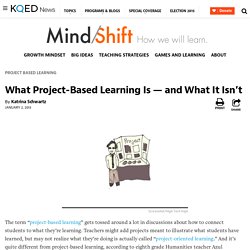

Are You Using Projects or Project-Based Learning? As we head into spring, there’s a bit of “lightness” ahead.
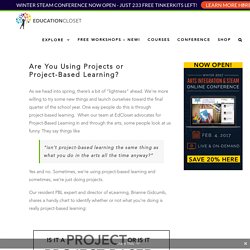
We’re more willing to try some new things and launch ourselves toward the final quarter of the school year. Students communicate their results. I am interested in strategies to help students write lab reports.

I have gone over this at the beginning of the year and a few times in between. But students still have trouble explaining the purpose, hypothesis, process, and conclusion. 10 Tips For Launching An Inquiry-Based Classroom. Transforming teaching practices is a long, slow road. But increasingly schools and teachers experiencing success are sharing their ideas online and in-person. Science Leadership Academy opened as a public magnet school almost ten years ago in Philadelphia.
The educators that make up the school community have spent nearly half that time sharing best practices through a school-run conference each year and more recently by opening a second school in Philadelphia. Diana Laufenberg was one of the first SLA teachers and has gone on to help foster inquiry at schools around the country, most recently by starting the non-profit Inquiry Schools. Twenty Ideas for Engaging Projects. The start of the school year offers an ideal time to introduce students to project-based learning.
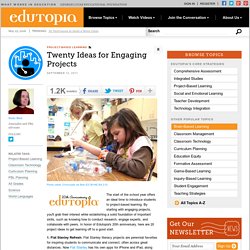
By starting with engaging projects, you'll grab their interest while establishing a solid foundation of important skills, such as knowing how to conduct research, engage experts, and collaborate with peers. In honor of Edutopia's 20th anniversary, here are 20 project ideas to get learning off to a good start. 1. Flat Stanley Refresh: Flat Stanley literacy projects are perennial favorites for inspiring students to communicate and connect, often across great distances. Now Flat Stanley has his own apps for iPhone and iPad, along with new online resources. 2. 3. 4. 5. 6. 7. Gold Standard PBL: Essential Project Design Elements. Adapted from Setting the Standard for Project Based Learning: A Proven Approach to Rigorous Classroom Instruction, by John Larmer, John Mergendoller, Suzie Boss (ASCD 2015).
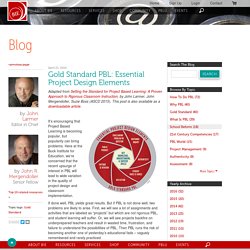
This post is also available as a downloadable article. It’s encouraging that Project Based Learning is becoming popular, but popularity can bring problems. Here at the Buck Institute for Education, we’re concerned that the recent upsurge of interest in PBL will lead to wide variation in the quality of project design and classroom implementation. If done well, PBL yields great results. But if PBL is not done well, two problems are likely to arise. Gold Standard PBL: Project Based Teaching Practices. Adapted from Setting the Standard for Project Based Learning: A Proven Approach to Rigorous Classroom Instruction, by John Larmer, John Mergendoller, Suzie Boss (ASCD 2015).
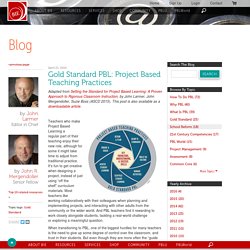
This post is also available as a downloadable article. Teachers who make Project Based Learning a regular part of their teaching enjoy their new role, although for some it might take time to adjust from traditional practice. It’s fun to get creative when designing a project, instead of just using “off the shelf” curriculum materials. Most teachers like working collaboratively with their colleagues when planning and implementing projects, and interacting with other adults from the community or the wider world. And PBL teachers find it rewarding to work closely alongside students, tackling a real-world challenge or exploring a meaningful question. When transitioning to PBL, one of the biggest hurdles for many teachers is the need to give up some degree of control over the classroom, and trust in their students. Implementing Project-Based Learning in the 21st Century - Learning Deeply. MindShift sur Twitter : "Can Project-Based Learning Close Gaps in Science Education? #edchat #scichat #pbl.
Can Project-Based Learning Close Gaps in Science Education? Putting kids to work on meaningful projects can transform classrooms into beehives of inquiry and discovery, but relatively few rigorous studies have examined how well this teaching method actually works.

An encouraging new report describes preliminary, first-year outcomes from a study of 3,000 middle school students that shows kids can, in fact, learn more in science classrooms that adopt a well-designed, project-focused curriculum. When researchers analyzed test scores from those classrooms by students’ gender and ethnicity, there were no differences in learning performance. That’s a preliminary indication that high-quality project-based curricula might be able to help narrow the science education achievement gap in children from low-income backgrounds or other groups that are underrepresented in STEM fields.
How well the benefits hold up or grow in the second year of implementation remains to be seen. Access to good science curriculum materials is a “vexing issue,” Harris said. How to Reinvent Project Based Learning to Be More Meaningful. By Thom Markham This is a crucial time for education.

Every system in every country is in the process of figuring out how to reboot education to teach skills, application, and attitude in addition to recall and understanding. Helping students be able to grapple with increased problem solving and inquiry, be better critical and creative thinkers, show greater independence and engagement, and exhibit skills as presenters and collaborators is the challenge of the moment.
What Project-Based Learning Is — and What It Isn’t. Screenshot/High Tech High.
